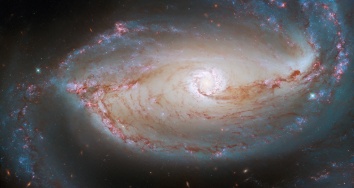
This image shows the heart of the barred spiral galaxy NGC 1097, as seen by NASA’s Hubble Space Telescope. Courtesy of NASA.
27 March 2024
BY ESTHER ROBARDS-FORBES
NASA’s newly announced space telescope project, UVEX (Ultra Violet EXplorer), will have researchers from The University of Texas at Austin leading several key projects as the mission examines how galaxies and stars evolve.
The estimated $300 million UVEX telescope is expected to launch in 2030 and will examine ultraviolet light sources in the universe. UT astronomer Danielle Berg will lead the UV galaxy spectroscopy portion of the UVEX mission. Its charge includes selecting and observing nearby, small, faint galaxies whose chemical makeup make them otherwise difficult to see, offering a first glimpse of galaxies with conditions similar to those in the early universe. The UVEX observations are specially designed to target traces of carbon and oxygen in the pristine extragalactic laboratories, with the hopes of better understanding the events that produce these life-essential elements. The insights could provide new ideas about the seeds of the first stars and galaxies.
The team’s work comprises approximately 10% of the overall mission for the new telescope. Berg and her colleagues are already hard at work preparing to take advantage of the new space telescope’s cutting-edge technology by using existing galactic imaging surveys in conjunction with ground-based telescopes at the McDonald Observatory to select the best candidates for UVEX to study.
“A lot of people are familiar with the Hubble Space Telescope and the incredible images we’ve taken with it,” said Danielle Berg, assistant professor of astronomy and core faculty member in UT’s new Cosmic Frontier Center. “But that equipment is nearly 35 years old. We don’t know how much longer it’s going to last, and it doesn’t really have the capabilities we need to view these very faint galaxies. UVEX will be able to image the entire sky and go 10 times deeper and with better spatial resolution. It will provide a huge leap forward in terms of what we can discover and learn.”
In addition to conducting a high-resolution all-sky imaging survey and a study of the chemical enrichment in the smallest galaxy building blocks, UVEX will be able to quickly point toward sources of ultraviolet light in the universe to capture transient events. This will enable it to capture energetic cosmic events, such as massive stars exploding as supernova at the ends of their lives, tidal disruption events where a black hole rips apart a companion star and the explosions that follow bursts of gravitational waves caused by merging neutron stars and black holes. The telescope will also use its ultraviolet spectrograph to study massive stars. Leading up to the launch, Berg and her team will utilize the Hobby-Eberly Telescope, a 10-meter telescope designed for spectroscopy and based at UT’s West Texas observatory, to identify promising candidates to study.
“With McDonald Observatory supporting the mission, we have some of the best telescopes in the world helping to select the very best sample before launch and following it up to collect additional data alongside UVEX after launch,” Berg said.
The telescope’s ultraviolet survey will complement data from other missions conducting wide surveys in this decade, including the Euclid mission led by ESA (European Space Agency) with NASA contributions, and NASA’s Nancy Grace Roman Space Telescope, set to launch by May 2027. Together, these missions will help create a modern, multi-wavelength map of our universe, according to NASA’s press release.
UVEX is different from the James Webb Space Telescope, which launched in 2021 and also boasts UT Cosmic Frontier Center astronomers as project leads. While UVEX observes light in the ultraviolet spectrum of galaxies in our cosmic backyard, James Webb observes the ultraviolet light emitted from very distant galaxies in the early universe that has been shifted to redder infrared wavelengths as it travels through the expanding Universe. In this sense, UVEX will provide the detailed ultraviolet maps of star-forming galaxies needed to interpret the distant signals received with James Webb.
“We’re excited to study some extremely high-energy galaxies and answer some questions about what is powering the phenomena we’re seeing,” Berg said. “We can learn so much about the early universe by studying these low-mass, chemically young galaxies.”
The UVEX mission’s principal investigator is Fiona Harrison at Caltech in Pasadena, California. Other institutions involved in the mission include University of California at Berkeley, Northrop Grumman and Space Dynamics Laboratory.

This image shows the heart of the barred spiral galaxy NGC 1097, as seen by NASA’s Hubble Space Telescope. Courtesy of NASA.